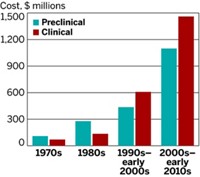Advertisement
Grab your lab coat. Let's get started
Welcome!
Welcome!
Create an account below to get 6 C&EN articles per month, receive newsletters and more - all free.
It seems this is your first time logging in online. Please enter the following information to continue.
As an ACS member you automatically get access to this site. All we need is few more details to create your reading experience.
Not you? Sign in with a different account.
Not you? Sign in with a different account.
ERROR 1
ERROR 1
ERROR 2
ERROR 2
ERROR 2
ERROR 2
ERROR 2
Password and Confirm password must match.
If you have an ACS member number, please enter it here so we can link this account to your membership. (optional)
ERROR 2
ACS values your privacy. By submitting your information, you are gaining access to C&EN and subscribing to our weekly newsletter. We use the information you provide to make your reading experience better, and we will never sell your data to third party members.
Pharmaceuticals
PhRMA Looks To The Future
Pharmaceutical Research & Manufacturers of America official lays out industry group's concerns and ways to address them
by Rachel Petkewich
June 19, 2006
"We've come a long way from old home remedies to prescription medicines," notes the website of the Pharmaceutical Research & Manufacturers of America (PhRMA), an industry group that represents companies that design and manufacture prescription drugs.
Alan Goldhammer, the organization's associate vice president for regulatory affairs, has been with the organization since 1999 and says there's a lot to do. The Ph.D. chemist summarizes three major concerns for member companies: reducing cost and time to get drugs to market, educating consumers and health care professionals about the risks of prescription drugs, and battling the counterfeit drug trade.
Bringing down the cost and time of drug development is key, Goldhammer says. "The cost is now more than $800 million to successfully bring a new drug to the market, and the time is on the order of about 12 years." Most senior people in R&D don't believe that escalating costs and time frames are sustainable, he adds. A shift in thinking in the industry toward biomarker research and redesigned clinical trials is under way.
A bigger problem is trying to better convey an understanding of the benefits and risks of medicines to doctors and health care professionals, Goldhammer says. "There will always be issues relative to various drugs that may or may not be fully known." The organization hopes that all patients given a new prescription will have a really good understanding of it, particularly if the drug is new to the market, when they leave the physician's office.
One of Goldhammer's projects at PhRMA deals with securing the chain of drug supply and distribution and reducing the incidence of counterfeit or diverted medicines in the U.S. Products such as human growth hormone and drugs for HIV, cholesterol, and impotence are targets. The Food & Drug Administration and the National Association of Boards of Pharmacy are also involved.
Goldhammer says the pharmaceutical industry has shown a lot of interest in using radio-frequency identification technology in tracking packaged pharmaceuticals throughout the supply chain. That technology certainly shows how far prescription medicines have advanced from old home remedies.




Join the conversation
Contact the reporter
Submit a Letter to the Editor for publication
Engage with us on Twitter